
Let's get this straight, once and for all: Fitness doesn't have to be complicated and confusing. In fact, that's the beauty of exercise — it can (and should) be whatever you need it to be.
But when you're just getting started, knowing what you need and navigating the world of workouts is daunting. That's why we've broken down everything you need to know and the steps you need to take to get started with any new workout routine — whether you're interested in taking up running, learning how to use gym machines, trying a Pilates class or just understanding your coworker's obsession with CrossFit.
First tip: Start small. Try a few different types of exercise to see what you like and log just 10, 15 or 20 minutes of activity. Eventually, you can work your way up to the recommended 150 minutes of moderate-intensity aerobic activity each week (we like to think of it as five 30-minute workouts a week), according to the Physical Activity Guidelines for Americans, and two weekly full-body strength-training sessions.
Now let's take a look at the most popular types of workouts for beginners so you can find the right routine for you and get going!
Toe the Starting Line of a Running Routine
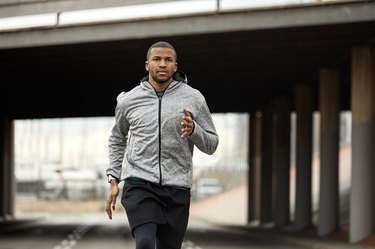
Best for: People who crave consistency and don't mind high-impact workouts (which can be tough on joints).
Running is a fairly natural movement, but turning it into a consistent workout requires a bit of advance planning and strategy. Essentially, there are three steps to take before you get running:
- Set a goal. Running a 5K, losing weight or improving your overall health are all good options.
- Find a training plan. There are plenty tailored to transitioning from walking to running or training for a specific distance.
- Invest in a few key pieces of clothing and gear. Running shoes are probably the only absolute must when you're getting started, but the right socks, shorts, sports bras and watch can help.
Along the way, you can work on perfecting your running form (hint: stand tall and keep your feet under your hips), cross-train to prevent injuries (say, swap in an elliptical workout once a week) and create the perfect running playlist (choose songs around 120 beats per minute to propel you forward).
But there's no need to let those details overwhelm you. You can start simple with just 10 minutes.
"I would prefer people fall in love with the sport, have some time to enjoy it, then start incrementally challenging themselves with distance," says Lucas Larson, general manager and coach at Heartbreak Hill Running Company in Chicago.
Before you start pounding the pavement, check out our beginner's guide to running.
Create Your Own Beginner Gym Workouts
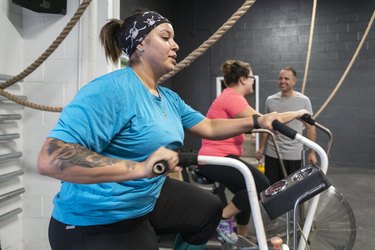
Best for: People who have access to a variety of workout machines and enjoy working out in a group setting.
Anyone experiencing a bit of "gym-timidation" can put those fears to rest. "Never be afraid or uncomfortable to look silly at the gym, there is most definitely someone there to help," says Jennifer Emge, a coach who creates personalized exercise plans at Courage to Sweat.
Often, that help comes in the form of a complimentary personal-training session when you sign up for your gym membership. "I'd use your first session with your trainer to set intent and to identify your strengths and weaknesses through a gait analysis and a breakdown of your movement," says Michael Moody, a personal trainer and host of the podcast The Elements of Being.
From there, you can explore all that your gym has to offer, including finding your favorite cardio machine (walking on the treadmill is a great place to start), mastering the weight room (keep scrolling for more on beginner strength training) and experimenting with group fitness classes (like a fun, fast-paced Zumba dance class).
Here's everything you need to know to get started at the gym.
Start Strength Training
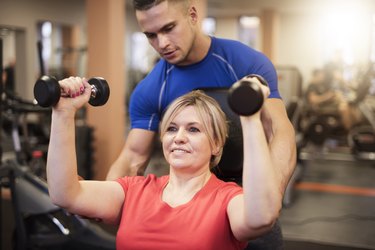
Best for: Everyone! Strength training is crucial for living a long, healthy life, and there's a form that works for just about anybody.
Aside from building muscle mass and helping you look either toned or "swole," depending on your routine and goals, strength training builds, well, strength to complete everyday tasks injury-free and increase your likelihood of living a long, independent life.
You can make plenty of progress using just your body weight before you advance to lifting weights like dumbbells, kettlebells or barbells.
- Body-weight exercises, such as squats, lunges and push-ups, don't require any fancy equipment, so you can do them anywhere.
- Dumbbells are the free weights you've probably seen most frequently (two weighted sides are connected by a handle usually held in one hand). They're the easiest and safest way to start adding weight to exercises once you've mastered proper form.
- Kettlebells are large, globe-shaped weights with curved handles on top that can replace dumbbells in certain exercises or be used in specialized movements like the kettlebell swing and snatch.
- Barbells usually weigh 35 to 45 pounds and can be used for exercises like the chest press and deadlift either with or without weight plates added to the ends of the long bar.
Find a beginner strength-training workout that fits your goals and preferences.
Try a HIIT Workout for Beginners
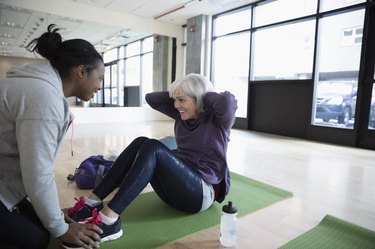
Best for: People who have packed schedules and like to switch things up.
The biggest perk of high-intensity interval training (HIIT) is you get an amazing workout in a short amount of time. By alternating between all-out bursts of effort (think: sprinting) and rest or active recovery (like walking), you're maximizing your calorie burn in a fraction of the time of steady-state (read: longer, more consistent intensity) workouts, according to a December 2017 study in Biology of Sport.
Another of HIIT's greatest draws is its versatility. "There is no limit to the kinds of HIIT training sessions you can complete with a full gym or with minimal equipment," says James Swift, certified personal trainer and owner of Fit Body Boot Camp in Rancho Cordova, California.
For example, you could do 20 seconds of body-weight squats, rest for 10 seconds, then do 20 seconds of push-ups, followed by another 10-second rest. Repeat that for 4 rounds total, and you have a full-body Tabata workout (a type of HIIT centered around the 20 seconds of work/10 seconds of rest ratio). Or you can run for 30 seconds, then walk for 30 seconds and repeat for 15 minutes. It's that simple!
If you're ready to HIIT your workout, make sure you prepare yourself — physically and mentally.
Begin Your CrossFit Journey
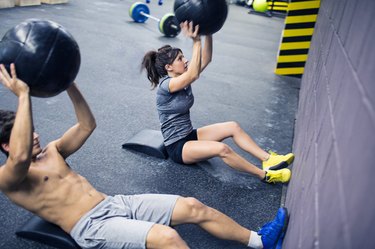
Best for: People looking for a challenge and constantly varied strength-focused workouts.
Back when CrossFit first emerged — and even today in some circles — it was a workout reserved for people who wanted to "get jacked." But it's now found a wider audience, including beginners, thanks to its emphasis on intro classes and mobility exercises that focus on healthy joint movement.
You don't have to just walk into a box (what CrossFitters call their gym) and jump into a WOD (workout of the day). Most reputable affiliates have a beginner on-ramp program that includes a series of classes to teach you the basics. You'll learn the foundational movements of CrossFit, what to expect in other classes and how to decode CrossFit lingo.
Because CrossFit is designed to be a vigorous workout that you can scale to match your fitness level, the most important thing is to start slowly and to not push yourself too hard.
"All of the criticism and problems with CrossFit come from people who put intensity ahead of everything else, and that's a massive mistake," ACE-certified personal trainer Jonathan Ross tells LIVESTRONG.com.
Have the best (and safest) first CrossFit workout with these tips.
Give Pilates a Try
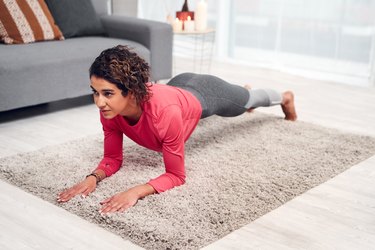
Best for: People looking for a low-impact (aka joint-friendly) workout that's great for the core.
Pilates is one of the easiest workouts to start because all you need is a mat or square of carpet and the willingness to learn. And thanks to the internet, you can find a wealth of videos and streaming classes you can do at home or anywhere else that's convenient.
Even better, it's a workout that meets you wherever you are: "Each Pilates exercise can be modified or advanced, which means there are endless possibilities for growth, and it doesn't have to be intimidating for someone who's never tried it before," says Michelle Yard, certified Pilates instructor at Urban Asanas.
All Pilates exercises stem from your core — which Pilates devotees call "the powerhouse" — making it a challenging ab workout that also hits every other major muscle. And regardless of whether you do a mat class on the floor or reformer Pilates (performed on a raised, moving bed with straps), it's a great low-impact option for anyone with knee or back pain.
Carve your core while being kind to your joints with these beginner Pilates exercises.
Find Your Inner Yogi
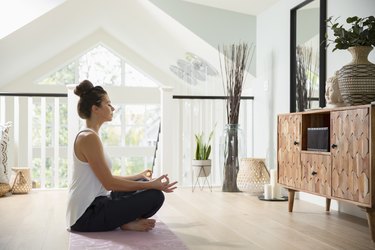
Best for: People rehabbing an injury, working on flexibility or looking for a low-impact cross-training workout.
When you're just starting a yoga practice, you'll want to figure out which type of class you prefer. "What I would recommend for a beginner is to find a studio that has a beginner series," says Washington-based yoga teacher Cara Maclean. Here are a few of the most common types of yoga:
- Vinyasa: One of the most common in the U.S., this form of yoga involves linking together a string of poses and moving with your breath.
- Bikram or Hot Yoga: This type features a set of 26 poses done in a room heated to 105 degrees Fahrenheit and 40 percent humidity.
- Ashtanga: Expect a series of poses that builds on itself as your practice progresses.
- Iyengar: Teachers spend extra time explaining alignment, making this a good option if you're interested in the mechanics of each pose and honing your form.
- Yin or Restorative: These classes focus on slow movements and longer time spent in each pose to help you relax.
Here's how to decide what type of yoga is right for you and what to expect in class.